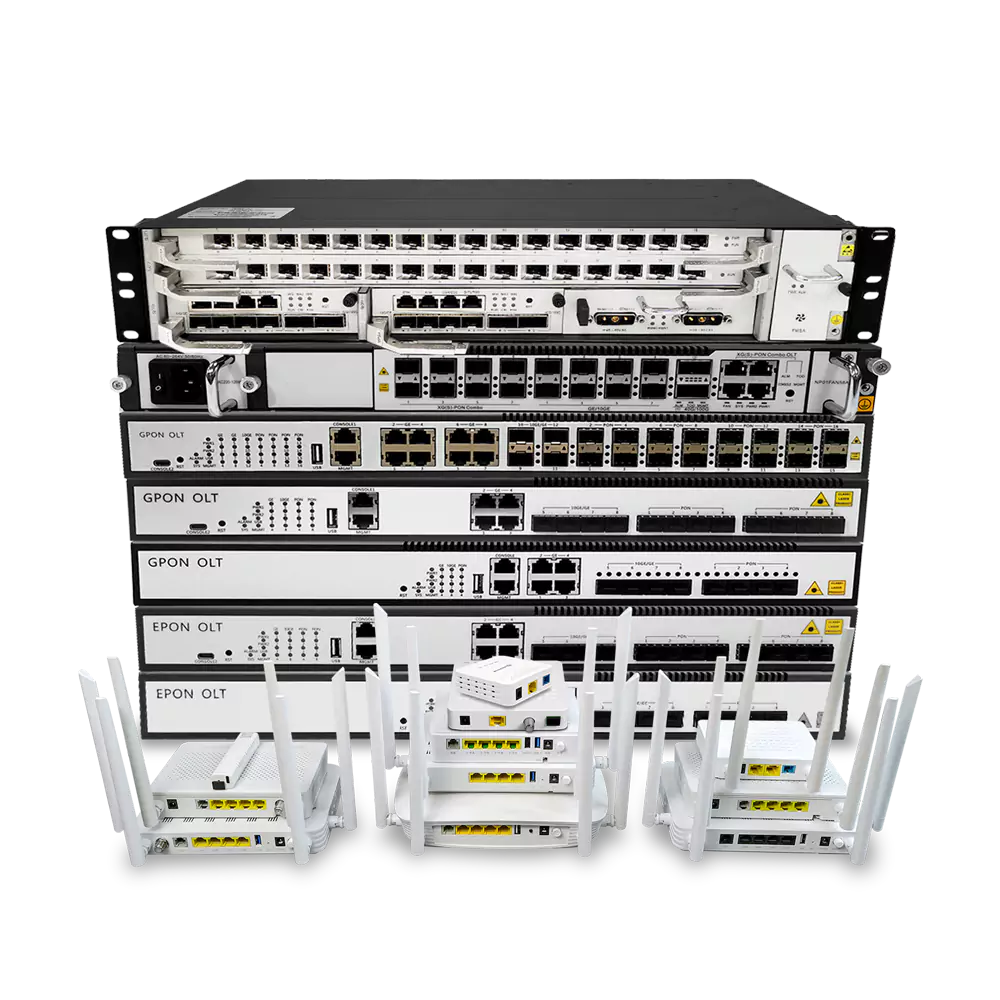An OLT (Optical Line Terminal) is a device used in fiber-optic networks, particularly in Passive Optical Networks (PON), which is usually located at the service provider’s central office (CO). The OLT’s primary function is to transmit high-speed data to multiple end-user devices (like ONUs or ONTs) via fiber optics. It serves as the bridge between the service provider’s data network and the fiber access network, such as FTTH (Fiber to the Home) or FTTB (Fiber to the Building) networks.
Key Functions of OLT
- Signal Transmission and Conversion: Converts electrical signals from the service provider’s network into optical signals for transmission to ONUs/ONTs, and vice versa.
- User Management and Authorization: Manages and controls the connected ONU/ONT devices, ensuring only authorized users can access the network.
- Traffic Management and QoS: Supports traffic control and Quality of Service (QoS), ensuring that different types of traffic (e.g., voice, video, data) are allocated appropriately.
- Fault Monitoring and Diagnostics: Provides network fault detection and diagnostics, allowing remote monitoring of ONU status, which enhances network stability and reliability.
Types and Specifications of OLTs
OLTs can be categorized based on the technology they support, application scenarios, and other specific features. Here are some common classifications:
Based on PON Technology
- EPON OLT: Supports EPON (Ethernet Passive Optical Network) technology with symmetrical upstream and downstream bandwidth of 1.25Gbps, typically used for Ethernet access.
- GPON OLT: Supports GPON (Gigabit Passive Optical Network) technology, providing 2.5Gbps downstream and 1.25Gbps upstream, widely used in FTTH and FTTB for higher bandwidth needs.
- 10G EPON OLT: Supports 10G EPON technology, with a maximum downstream rate of 10Gbps and upstream rate of 1Gbps or 10Gbps.
- XG-PON OLT: Supports XG-PON (10-Gigabit-capable Passive Optical Network) with 10Gbps downstream and 2.5Gbps upstream, suitable for high-bandwidth applications.
- XGS-PON OLT: Supports XGS-PON (10-Gigabit Symmetric Passive Optical Network), providing symmetric 10Gbps for both upstream and downstream, ideal for scenarios requiring symmetrical high bandwidth.
Based on Port Number and Bandwidth
- Low-Port OLT: Usually has 2-8 PON ports, suitable for small networks or access scenarios with fewer users.
- Mid-Port OLT: Typically has 8-16 PON ports, used in medium-sized networks.
- High-Port OLT: Generally has 16-64 or more PON ports, suitable for large networks or service provider applications.
- Aggregation OLT: Offers higher bandwidth capacity and port density, used in data centers, enterprise networks, or large-scale service scenarios.
Based on Form Factor
- Rack-mounted OLT: Typically a 1U or 2U rack-mounted device, suitable for centralized installation in data centers, meeting large network needs.
- Box-type OLT: Compact size, suitable for smaller environments such as small offices, branch offices, or campuses.
Sample Specifications
OLT specifications vary by manufacturer and model, but typical parameters include:
- GPON Port Count: Often includes 8, 16, 32, or 64 PON ports, with each port capable of connecting up to 128 users (using optical splitters).
- Uplink Interfaces: Usually includes multiple 10Gbps or 40Gbps Ethernet interfaces for connection to the core network.
- Forwarding Capacity: Could be 128Gbps, 256Gbps, or higher to support large-scale data processing and forwarding.
- Service Support: Supports a variety of services, including voice (VoIP), video (IPTV), data (Internet), and enterprise dedicated lines.
- Power Redundancy: Most OLTs support dual power redundancy to enhance reliability.
- Management Options: Supports various management methods such as SNMP, CLI, and Web interface for remote monitoring and configuration.
OLT Applications
OLTs are commonly used in various fiber access scenarios, including:
- FTTH (Fiber to the Home): Connecting directly to residential users, offering high-speed internet, IPTV, VoIP, etc.
- FTTB (Fiber to the Building): Connecting to multi-dwelling units or commercial buildings.
- FTTO (Fiber to the Office): Providing enterprise-grade fiber access services, typically used by small and medium-sized businesses.
As the core equipment in PON networks, OLTs play a vital role in enabling fiber-to-the-premises connections and supporting high-bandwidth networks. Different types and specifications of OLTs are designed to meet the diverse needs of network scale and bandwidth requirements, helping to deliver efficient, stable, and flexible fiber access networks.

